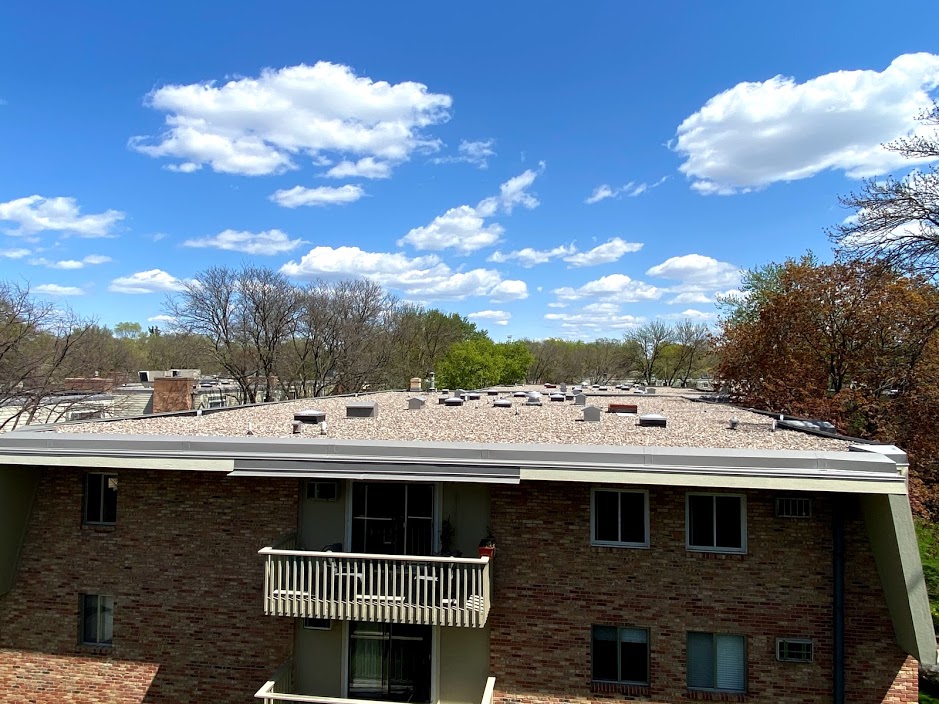Is my roof really flat?
While your roof may be considered a “flat” roof, it is not truly flat. A totally flat roof would never drain. It’s recommended that every roof has a slope to direct water to drains at its center or perimeter.
A properly designed flat commercial roof will move water quickly to its drainage system. Water that does not have a drainage pathway will accumulate, unnecessarily adding weight to your roof. If there is any breach in the roof membrane or flashings, this standing water will find its way into the building.
Gravity is your roof’s best friend when your drainage system is in good working order. But it can also be your worst enemy as water tries to find its way to the ground. Pooled water will find the most minor crack or hole in your roof membrane or flashing and work its way inside. Standing water also degrades the underlying structure of your roof over time. It’s a warning sign that your roof is not draining correctly.
Get to know your drains.
It’s essential to know where your drains are and inspect them between scheduled roof maintenance appointments. It doesn’t matter how new or well-designed your commercial roof is – if it has damaged or clogged drains, you need to take immediate action.
Flat commercial roofs have several different drain systems, and many use a combination of methods. Your Mint Roofing expert can show you where your drains are and what to watch for.
Interior Drains
Interior drains are like the drain in your shower. They are positioned at a low point on your commercial roof and collect water from all directions. They are often covered with a leaf guard, which is an inverted strainer that collects leaves and twigs.
Interior drains are perfect for Minnesota winters because they keep melting snow and pooled water away from the outside walls and foundation of the building. Because they drain through pipes inside the warm building, they are not susceptible to freezing or cracking.
Overflow drains are often installed to discharge pooled water if the main drain is clogged with debris.
Since interior drains are usually covered by interior ceilings, walls, or beams inside the building, they are the most expensive drains to repair.
Edge Drains and Scuppers
As the name suggests, edge drains collect water around the perimeter of your roof and discharge it through a drainpipe or downspout on the outside of the building. As with home gutters, their purpose is to direct the water flow to prevent seeping back into the foundation or pooling in public areas.
Scuppers are a type of edge drain that appear as a rectangular opening located around the perimeter of your roof. They move water quickly off the roof and down an external downspout. Because they have a large opening, they are less prone to clogging than other drain types.
Edge drains are a simple design and relatively inexpensive to repair. Still, since they are exposed to the elements, they are prone to freezing during the winter months.
Bottom line; Keep it clean!
The key to a trouble-free commercial roof is always proper maintenance. Get to know where your drains are and inspect them from time to time, especially after a major storm or in the Fall when trees are losing their leaves. If your drains are clogged and have water pooled up around them, try to clear the blockage immediately. If it still doesn’t drain, you’ll want to give us a call to get it fixed for you before water starts finding its way inside your building and does real damage.
How long has it been?
If it’s been more than 12 months since your last commercial roof inspection, you should call us to schedule a professional inspection today. Our experienced Mint Roofing commercial roof inspectors will give you a full report on the condition of your roof and make sure you’re ready for the winter months.
Phone: 952-473-8080 24-Hour Line: 952-473-8181 Email: info@mintroofing.com
FAQs


